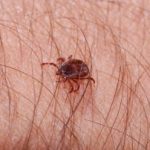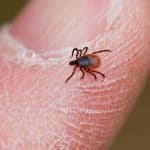Large mites (3 to 6 mm on average)The shape, size and color of ticks vary greatly depending on the species and its stage of development but their body is always oval and their head is extended by a rostrum equipped with two chelicerae.Their body is not segmented into 3 regions as in most arthropods.There are simply two parts: the head and body.The adult has eight legs.
Latin Name: Acarina
Description:Acarians of large size (3 to 6 mm on average)The shape, size and color of ticks vary greatly depending on the species and its stage of development but their body is always oval and their head is extendedd a rostrum equipped with two chelicerae.Their body is not segmented into 3 regions as in most arthropodsSimply distinguish two parts: the head and body.The adult has eight legs
Reproduction:Only the adult ticks mate. All known species of ticks, develop through four distinct evolutionary stages:1. egg 2. larva (which has only 3 pairs of legs, clawed)3. nymph (which has eight legs like the adult but without a genital opening)4. adultIn most cases, during its life cycle, a tick changes host at each of these stages.
Habitats: Ticks have varied habitats depending on the species. Some are very dependent on moisture and are either confined to forest or wooded environments or must remain in shelters of reduced size allowing the maintenance of moisture (nests, burrows, caves, stables …)Some species are adapted to dry climates, even desert. These are dispersed in edge vegetation, thickets or edges of pasture.In the larval and pupal stages they hunt small animals on low vegetation and when they become adults, they attack larger animals,carnivores, ungulates etc.
Prevention:The only way to avoid being bitten by a tick is to wear full-body clothing when walking in the wild.If you are bitten, you may not realize it right awaybecause the insect injects an anesthetic liquid for this purpose, do not panic and be careful how you remove it. In order to feed, the tick must push its head completely under the skin and if you extract the tick too quickly or crush it during the process, you run the risk of the tick spreading pathogens in the wound and possibly transmitting certain diseases such as lyme disease. To remove the tick, use fine tweezers, place the tweezers as close to the skin as possible and gently pull or lift the tick. You must be gentle because you must remove the head of the insect. If you do not feel able to remove the tick properly, it is best to seek medical attention.



